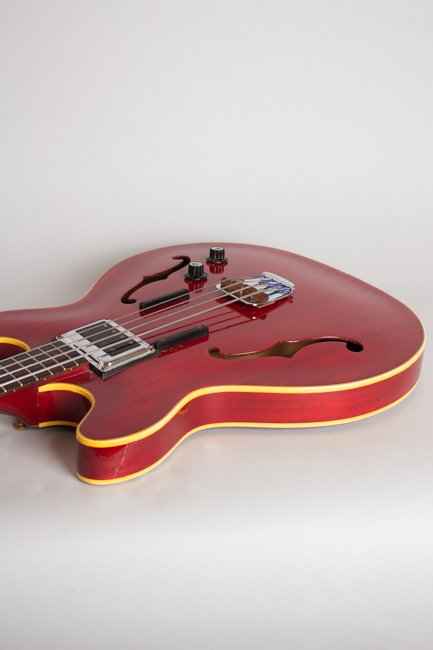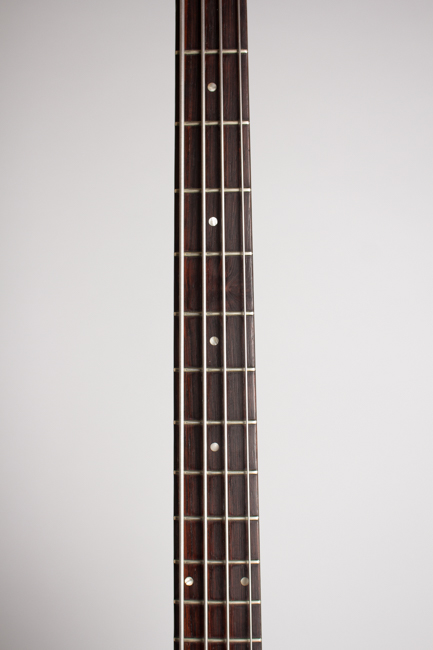Guild Starfire Bass Semi-Hollow Body Electric Bass Guitar (1967)
This item has been sold.
Item # 8050
Prices subject to change without notice.
Guild Starfire Bass Model Semi-Hollow Body Electric Bass Guitar (1967), made in Hoboken, NJ, cherry lacquer finish, laminated mahogany body and neck, rosewood fingerboard, black hard shell case.
The 1960s Guild Starfire bass has in recent years been re-gaining attention as one of the decade's most distinctive bass guitars. Despite its general resemblance to the Gibson EB-2 and Epiphone Rivoli, the Starfire is a completely different animal sonically, putting out a very clear and powerful sound with a wide frequency range and an almost piano-like growl unusual in a hollow-body bass.
Starfire basses became a prominent part of the San Francisco sound in the late '60s with both Phil Lesh of the Grateful Dead and Jack Casady of the Jefferson Airplane choosing the model for their psychedelic explorations of the low end. With a very slim and fast-playing neck, the Starfire is the perfect bass to "take off" on and remains as unique as when first designed.
Guild did not even enter the electric bass arena until 1965, when the semi-hollow double-cutaway Starfire line and the solid body line both had a single-pickup bass added. While the solid body Jetstar soon crashed and burned the Starfire became one of the company's most popular items. The neck is very slim and comfortable to play, especially compared to most other American basses of the 1960s. The body is not fully hollow, there is a solid block running through the center in the manner of a Gibson ES-335 giving a tighter response and more resistance to feedback than a true hollowbody bass.
The real secret to the early Guild basses' unique sound is the large Hagstrom-made Bi-Sonic pickup, which looks like a double-coil unit but is in fact more akin to a giant single-coil DeArmond. With large magnet slugs for polepieces, this pickup has a very powerful attack and a broad harmonic range quite unlike either the more familiar giant Gibson bass humbucker or the Guild humbucking pickup which replaced it in 1970.
This particular Starfire is from mid-1967 and has features specific to that period. The major difference from the earlier models is the pickup position, mounted just under the fingerboard: the earliest Starfire basses feature the single P.U. closer to the bridge. This bass pre-dates the introduction of the baritone tone switch added in late 1967. The tuners are typical American-made Klusons where the very first models had European Van Ghents. The triple bound body is finished in a deep cherry red finish. This bass has some light signs of wear from use but remains a fine example of this 1960s classic.
Overall length is 46 in. (116.8 cm.), 16 1/4 in. (41.3 cm.) wide at lower bout, and 1 3/4 in. (4.4 cm.) in depth, measured at side of rim. Scale length is 30 1/2 in. (775 mm.). Width of nut is 1 1/2 in. (38 mm.).
This bass is nicely original and in excellent playing condition with just some light fairly typical finish wear. The cherry lacquer overall is well-preserved with small chips and dings, two small areas of belt-buckle wear on the back, a wear spot on the lower side, and a small spot of finish worn away just above the upper finger rest. The deep red cherry color is still very strong with some typical checking. The neck finish has the edges worn down a bit, and there are some small dings to the back of the neck. There is some light corrosion to some of the plating.
The only alteration is one of the tuner shaft screws is a later replacement, fairly common as they often fell out unnoticed! The serial number on the headstock rear has an extra digit added after the last number from the factory, the sort of odd but not unknown error sometimes seen on period Guilds…this is the second we have had like this. Overall a fine gigging Starfire bass, with an excellent straight neck with good angle, and the typical wonderful sound. This bass comes in a period but not Guild-made HSC that is a functional, if not exact, fit. Excellent - Condition.
The 1960s Guild Starfire bass has in recent years been re-gaining attention as one of the decade's most distinctive bass guitars. Despite its general resemblance to the Gibson EB-2 and Epiphone Rivoli, the Starfire is a completely different animal sonically, putting out a very clear and powerful sound with a wide frequency range and an almost piano-like growl unusual in a hollow-body bass.
Starfire basses became a prominent part of the San Francisco sound in the late '60s with both Phil Lesh of the Grateful Dead and Jack Casady of the Jefferson Airplane choosing the model for their psychedelic explorations of the low end. With a very slim and fast-playing neck, the Starfire is the perfect bass to "take off" on and remains as unique as when first designed.
Guild did not even enter the electric bass arena until 1965, when the semi-hollow double-cutaway Starfire line and the solid body line both had a single-pickup bass added. While the solid body Jetstar soon crashed and burned the Starfire became one of the company's most popular items. The neck is very slim and comfortable to play, especially compared to most other American basses of the 1960s. The body is not fully hollow, there is a solid block running through the center in the manner of a Gibson ES-335 giving a tighter response and more resistance to feedback than a true hollowbody bass.
The real secret to the early Guild basses' unique sound is the large Hagstrom-made Bi-Sonic pickup, which looks like a double-coil unit but is in fact more akin to a giant single-coil DeArmond. With large magnet slugs for polepieces, this pickup has a very powerful attack and a broad harmonic range quite unlike either the more familiar giant Gibson bass humbucker or the Guild humbucking pickup which replaced it in 1970.
This particular Starfire is from mid-1967 and has features specific to that period. The major difference from the earlier models is the pickup position, mounted just under the fingerboard: the earliest Starfire basses feature the single P.U. closer to the bridge. This bass pre-dates the introduction of the baritone tone switch added in late 1967. The tuners are typical American-made Klusons where the very first models had European Van Ghents. The triple bound body is finished in a deep cherry red finish. This bass has some light signs of wear from use but remains a fine example of this 1960s classic.
Overall length is 46 in. (116.8 cm.), 16 1/4 in. (41.3 cm.) wide at lower bout, and 1 3/4 in. (4.4 cm.) in depth, measured at side of rim. Scale length is 30 1/2 in. (775 mm.). Width of nut is 1 1/2 in. (38 mm.).
This bass is nicely original and in excellent playing condition with just some light fairly typical finish wear. The cherry lacquer overall is well-preserved with small chips and dings, two small areas of belt-buckle wear on the back, a wear spot on the lower side, and a small spot of finish worn away just above the upper finger rest. The deep red cherry color is still very strong with some typical checking. The neck finish has the edges worn down a bit, and there are some small dings to the back of the neck. There is some light corrosion to some of the plating.
The only alteration is one of the tuner shaft screws is a later replacement, fairly common as they often fell out unnoticed! The serial number on the headstock rear has an extra digit added after the last number from the factory, the sort of odd but not unknown error sometimes seen on period Guilds…this is the second we have had like this. Overall a fine gigging Starfire bass, with an excellent straight neck with good angle, and the typical wonderful sound. This bass comes in a period but not Guild-made HSC that is a functional, if not exact, fit. Excellent - Condition.








